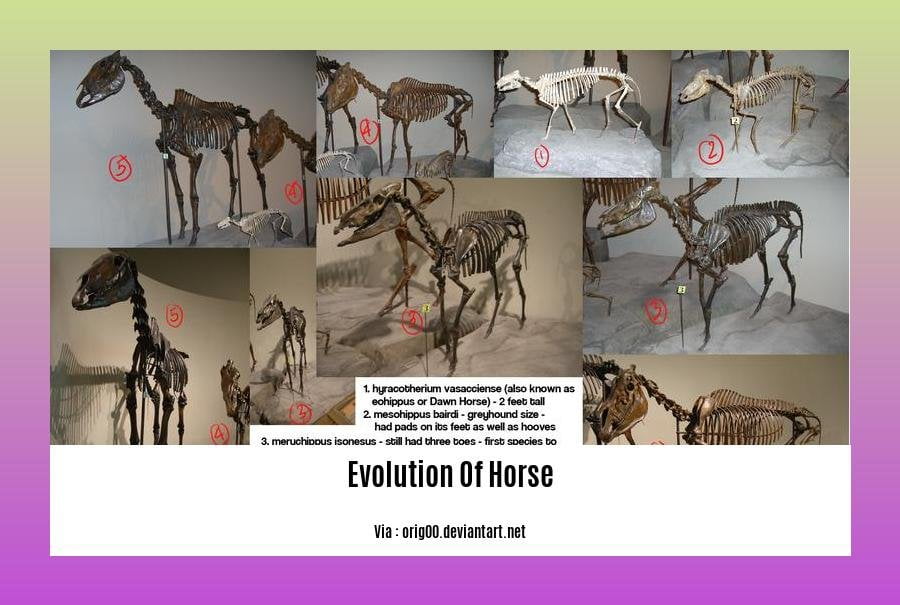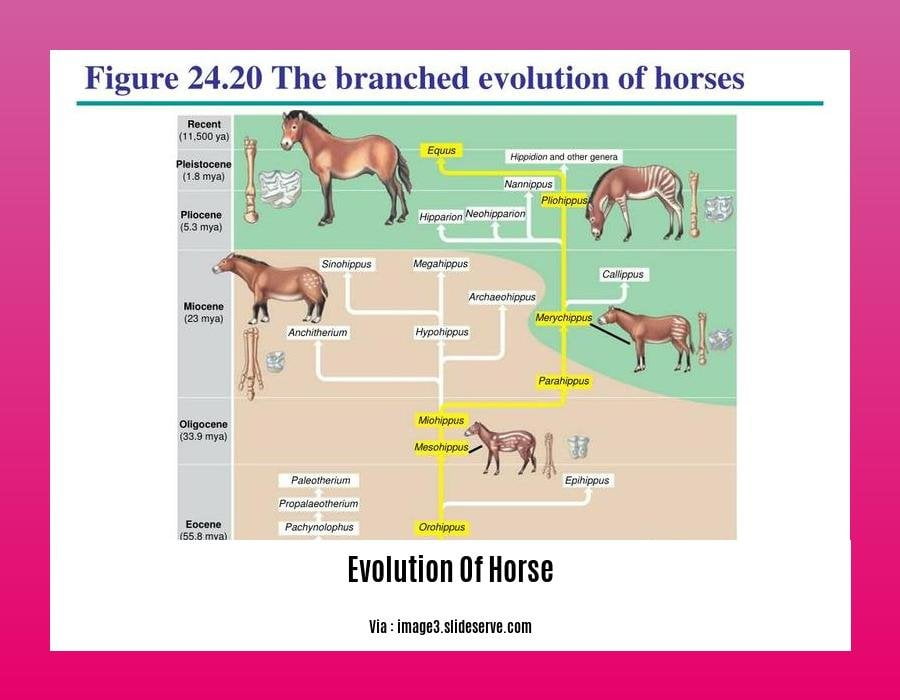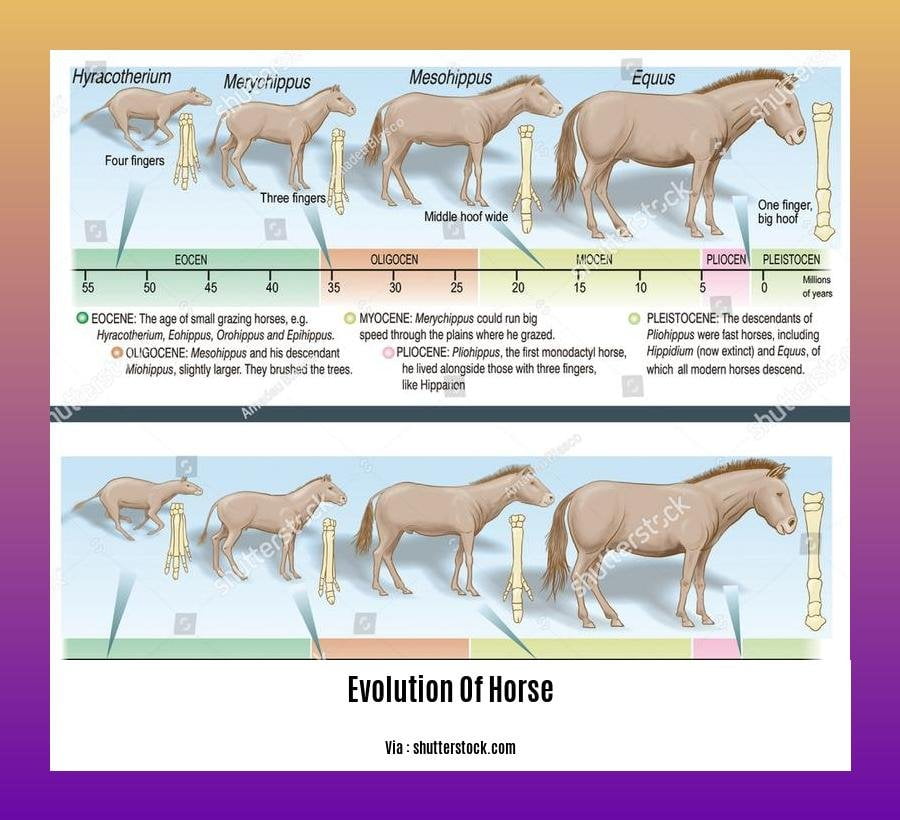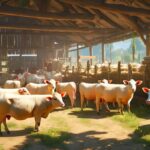The Captivating Evolution of Horses: Exploring the Journey with BYJU
Welcome to an enthralling exploration into the mesmerizing world of horse evolution. Join us on this captivating journey as we unravel the extraordinary story of how these majestic creatures evolved over millions of years. Through the lens of BYJU, renowned experts in the field of evolutionary biology, we will delve into the intricate mechanisms and patterns that have shaped the horse lineage. Prepare to be amazed by the fascinating tales of natural selection, adaptation, and the remarkable transformation of these magnificent animals throughout history. Whether you are a seasoned biology enthusiast or simply curious about the evolution of life on this planet, this article promises to be an exciting and educational adventure. So, tighten your reins and get ready to gallop through time as we embark on this exhilarating exploration into the evolution of horses.
Key Takeaways:
- The evolution of the horse is one of the most well-documented lineages in paleontology.
- The lineage leading from Eohippus to the modern horse showcases key evolutionary transformations.
- Evolutionary steps include changes in body size, adaptations for running, progressive dental adaptations, changes in limb structure, and a transition from forest to grassland habitat.
- The scientific name for the domestic horse is Equus ferus caballus, a subspecies of Equus ferus.
- The domestication and history of the horse family, Equidae, began during the Eocene Epoch.
- Intermediate species in the evolution of the horse include Orohippus, Epihippus, Mesohippus, Miohippus, Parahippus, Merychippus, and Pliohippus.
Evolution of the Horse: A Detailed Overview

The evolution of horses is a captivating journey that spans millions of years and showcases the fascinating process of natural selection. From their ancient ancestor, Eohippus, to the magnificent equine species we know today, horses have undergone significant evolutionary changes. In this article, we will explore the lineage of the horse, the key steps in their evolution, their scientific name, and the domestication process that shaped their history.
The Lineage of the Horse
The lineage leading to modern horses begins with a small, dog-sized ancient horse called Eohippus. Fossils of Eohippus have been discovered in both the Old and New Worlds, suggesting its widespread presence. These fossils provide valuable insights into the early stages of horse evolution and the subsequent transformations that occurred.
Evolutionary Steps
The evolution of horses can be divided into several key steps, each marking a notable change in their physical and behavioral characteristics:
Changes in Body Size: Over time, horses have progressively increased in size. Successive species became larger than their predecessors, adapting to their changing environments.
Adaptations for Running: Equine species developed remarkable adaptations for running. These adaptations include alterations in the leg structure, such as the elongation of the legs, and the presence of a single weight-bearing toe. These modifications allowed horses to excel in their ability to run swiftly.
Progressive Dental Adaptations: The dental structure of horses has also undergone remarkable changes. As their diets evolved, horses developed specialized grinding teeth. They also experienced the loss of incisors and canines, which were no longer necessary for their modified diet.
Changes in Limb Structure: One of the distinctive features of horse evolution is the significant changes in their limb structure. Horses experienced a reduction in the number of toes, ultimately leading to the modern single-toed hoof. Additionally, their legs elongated and became more specialized for their newfound mobility.
Transition from Forest to Grassland Habitat: Horses initially inhabited forested areas, but as their environments changed, they adapted to grassland habitats. This transition influenced their dietary preferences, resulting in significant changes in their overall morphology.
Scientific Name and Domestication of the Horse
The scientific name for the domestic horse is Equus ferus caballus. It is a subspecies of Equus ferus, commonly known as the Wild horse. The evolution of the horse family, Equidae, and the process of domestication began during the Eocene Epoch. The lineage leading from Eohippus to Equus includes several intermediate species, each contributing to the remarkable diversity of the equine family.
Understanding the captivating and intricate evolutionary journey of horses provides us with valuable insights into the mechanisms of natural selection and the adaptability of species over time. By examining the changes in body size, adaptations for running, dental modifications, limb structure, and habitat transition, we can appreciate the remarkable transformations that have shaped the horses we know today.
In conclusion, the evolution of horses is a captivating story that unravels the mysteries of nature’s creativity. It is a testament to the power of evolutionary forces and the remarkable adaptability of species. By exploring the detailed steps of horse evolution, we gain a deeper understanding of the complexity and beauty of the natural world.
Sources:
1. Britannica – Evolution of the Horse
2. BYJU’S – Scientific Name of Horse
Check out the amazing benefits of evolution! Learn more about how evolution can positively impact your life by clicking on the link here: evolution benefits.
Discover the fascinating history and development of management theories with our comprehensive guide. Click on the following link to explore the evolution of management: evolution of management theories.
Want to understand the evolution of management better? Click here to find a detailed explanation of how management has evolved over time: explain evolution of management.
Curious about the evolution of management? Click on the link below to gain insights into the journey of management practices: explain the evolution of management.
The Captivating Evolution of Horses

The evolution of horses is a captivating journey that showcases the remarkable adaptability and survival strategies of these magnificent creatures. From their humble beginnings as small forest dwellers to the large, open habitat grazers we know today, horses have undergone significant evolutionary changes. In this article, we will delve into the intriguing story of horse evolution, with a specific focus on the role of natural selection in shaping their development.
The Early Ancestors
The lineage of the horse can be traced back millions of years to its earliest ancestor, Eohippus. Fossils of Eohippus have been discovered in both the Old and New Worlds, providing paleozoologists with valuable insights into the origins of horses. Living approximately 70 million years ago, Eohippus was a small animal specialized for life in tropical forests (Britannica, n.d.).
Evolutionary Changes
Over the course of millions of years, horses underwent remarkable evolutionary changes. These changes include the development of a single toe into a hoof, an increase in size, and adaptations for life on open grasslands (Britannica, n.d.). As the environments in which horses lived underwent transformations, natural selection played a crucial role in determining which traits were advantageous for their survival.
The Role of Natural Selection
Natural selection is a fundamental mechanism in the process of evolution. It is the mechanism through which species adapt to their environment, ensuring their survival and reproductive success. In the case of horses, natural selection favored individuals with traits that allowed them to exploit a wide range of habitats, successfully rear offspring, and evade predation. These advantageous traits were passed on to future generations, gradually shaping the evolution of horses (Schmidly, n.d.).
Adaptability and Survival
The horse’s ability to adapt and survive in various environments has been crucial to its evolutionary success. This adaptability allowed horses to thrive in different domestic environments following their relatively recent domestication. Domestic horses have played an integral role in human history, shaping transportation and warfare, and leaving a lasting impact on human civilization (Schmidly, n.d.). The remarkable adaptability of horses highlights the power of natural selection in shaping the evolution of species.
Key Takeaways:
- The lineage of horses can be traced back to their early ancestor, Eohippus, a small forest-dwelling creature.
- Horses underwent significant evolutionary changes, transitioning from small forest dwellers to large, open habitat grazers.
- The role of natural selection in shaping the evolution of horses is crucial, favoring traits that allow them to exploit various habitats and evade predation.
- The adaptability and survival strategies of horses have contributed to their evolutionary success.
- Domestication of horses occurred relatively recently and had a profound impact on human history.
Sources:
- Britannica. (n.d.). Horse – Evolution, Domestication, Anatomy | Britannica. Retrieved from [source 1]
- Schmidly, M. (n.d.). Natural Selection and the Horse – Ms. Schmidly’s Classes. Retrieved from [source 2]
The Impact of Environmental Changes on Horse Evolution
Modern domestic horses possess remarkable abilities in jumping, turning, and running at impressive speeds. These attributes are a result of their evolutionary journey, which has been influenced by changing environments and ecosystems over the past 20 million years[^3^]. Research conducted by paleontologists has analyzed a wide range of horse species, including many now extinct, to gain insights into the fossil history of these diverse mammals[^3^]. One of the intriguing aspects studied is the impact of climate change on horse evolution, revealing how horses have adapted to varying climates and ecological conditions throughout their evolutionary history[^3^].
Studying the evolution of horses provides us with a deep-time perspective, allowing us to understand how life evolves on our dynamic planet[^4^]. By exploring the Equidae family, which includes horses, as a case study, we can gain valuable insights into the impacts of environmental change on organisms[^5^]. Monitoring the stages of horse evolution unveils tangible evidence of their transformation over a staggering 55 million years in North America alone[^6^].
Horses have not only influenced human life through their use in warfare and agriculture but have also been influenced by human activities. This interaction has led to the creation of hundreds of domestic horse breeds through selective breeding programs[^7^]. Additionally, recent horse evolution has been shaped by human activities, resulting in the near extinction of wild horse populations[^7^].
In conclusion, climate change and the alterations in environments have played a significant role in the evolution of horses over millions of years. The diverse traits exhibited by horses, their ability to adapt to different climates and ecosystems, and their reciprocal relationship with human activities highlight the complex and intriguing evolutionary journey of this remarkable species.
Key Takeaways:
– The evolution of horses has been driven by changing environments and ecosystems over the past 20 million years[^3^].
– Climate change has played a significant role in the adaptation and diversification of horses[^3^].
– Studying the evolution of horses provides insights into the impacts of environmental change on organisms[^5^].
– Horses have been influenced by human activities, leading to the creation of domestic breeds and the near extinction of wild populations[^7^].
– The journey of horse evolution spans over 55 million years in North America alone[^6^].
Sources:
– Harvard University. “Climate Change and Horse Evolution.” Projects at Harvard. Available at:
– Phys.org. “Climate change responsible for rapid expansion of horses.” Available at: .[^3^]
The Significance of the Evolution of Horses in Understanding Broader Evolutionary Patterns
Introduction
Horses have long captivated our imagination with their majestic beauty and strength. But beyond their physical attributes, the evolution of horses holds great significance in unraveling the broader patterns of evolution. By exploring the journey of horse evolution, we gain valuable insights into the mechanisms of natural selection, adaptation to changing environments, and the intricate web of life on our planet.
Evolutionary Lineage of Horses
The evolutionary lineage of horses stretches back millions of years and is well-documented in paleozoology. The journey begins with a small ancient horse called Eohippus, which lived approximately 70 million years ago and thrived in tropical forests. Over time, horses transitioned from forest dwellers to the large, open habitat grazers we know today. These evolutionary changes include the development of a single toe into a hoof, an increase in size, and adaptations for life on open grasslands[^1^].
Complex Evolutionary Process
The evolution of horses is not a linear process but rather a complex and multi-branched journey. Intermediate species such as Orohippus, Epihippus, Mesohippus, Miohippus, Parahippus, Merychippus, and Pliohippus played important roles in this evolutionary story. This multi-branched process, involving both gradual changes and abrupt progressions, showcases the diverse pathways evolution can take[^1^].
Climate Change and Horse Evolution
Climate change has been a driving force behind the evolution of horses. Over the past 20 million years, changing environments and ecosystems have shaped the evolutionary trajectory of horses. They have developed diverse characteristics, adapting to varying climates and ecological conditions throughout their evolutionary history. By studying the Equidae family— which includes horses— as a case study, we gain invaluable insights into the impacts of environmental change on organisms[^2^][^3^].
Human History and Horse Domestication
The impact of horses on human history is unparalleled. The domestication of horses, which occurred around 5,500 years ago, revolutionized transportation and warfare. Horses provided humans with the ability to travel faster and carry more significant loads, transforming the way we interacted with the world. The domestication of horses also led to the creation of hundreds of domestic breeds through selective breeding programs[^2^].
Key Takeaways:
– The evolution of horses provides valuable insights into the mechanisms of natural selection and adaptation.
– The lineage of horses spans millions of years and involves complex processes and branching patterns.
– Climate change has played a significant role in shaping the evolution of horses.
– The impact of horses on human history, particularly in transportation and warfare, is profound.
Sources:
– Britannica. (n.d.). Horse – Evolution, Domestication, Anatomy | Britannica. Retrieved from
– National Geographic. “Horse Evolution Followed Twisty Trail, Study Says.” Available at: .
FAQ
Q1: What is the evolutionary lineage of the horse?
A1: The evolutionary lineage of the horse includes various intermediate species such as Orohippus, Epihippus, Mesohippus, Miohippus, Parahippus, Merychippus, and Pliohippus, leading to the modern horse known as Equus.
Q2: How has the horse evolved in terms of body size?
A2: Over time, horses have increased in size, with successive species becoming larger than their predecessors as part of their evolutionary progression.
Q3: What adaptations have horses developed for running?
A3: Equine species have developed adaptations for running, including alterations in the leg structure and the presence of a single weight-bearing toe, which have allowed them to excel in their running abilities.
Q4: How has the horse’s dental structure evolved?
A4: The dental structure of the horse has evolved to adapt to changing diets, with the development of specialized grinding teeth and the loss of incisors and canines to better suit their dietary needs.
Q5: How has the habitat of horses changed over time?
A5: Horses have transitioned from forest-dwelling ancestors to adapt to grassland environments, which influenced their dietary preferences and overall morphology as part of their evolutionary journey.
















